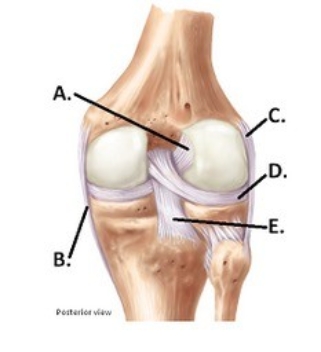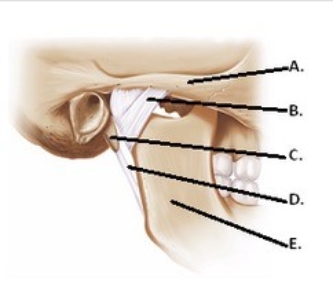A) circumduction
B) rotation
C) hyperextension
D) supination
E) pronation
Correct Answer

verified
Correct Answer
verified
Multiple Choice
The opposite of extension is ________.
A) inversion
B) protraction
C) elevation
D) pronation
E) flexion
Correct Answer

verified
Correct Answer
verified
Multiple Choice
When you walk up the stairs, your hip and knee joints ________ to lift your body weight.
A) rotate
B) abduct
C) adduct
D) flex
E) extend
Correct Answer

verified
Correct Answer
verified
Multiple Choice
 -The figure illustrates a posterior view of the right knee joint. What does "C" represent?
-The figure illustrates a posterior view of the right knee joint. What does "C" represent?
A) Medial (tibial) collateral ligament (MCL)
B) Posterior cruciate ligament (PCL)
C) Anterior cruciate ligament (ACL)
D) Lateral (fibular) collateral ligament (LCL)
E) Lateral meniscus
Correct Answer

verified
Correct Answer
verified
Multiple Choice
The thick fibrocartilage disks found in the knee joint are called ________.
A) bursae
B) ligaments
C) tendon sheaths
D) menisci
E) intraknee disks
Correct Answer

verified
Correct Answer
verified
Multiple Choice
 -The figure illustrates structures in the right temporomandibular joint (lateral view) . What does "D" represent?
-The figure illustrates structures in the right temporomandibular joint (lateral view) . What does "D" represent?
A) Lateral ligament
B) Mandible
C) Zygomatic arch
D) Styloid process
E) Stylomandibular ligament
Correct Answer

verified
Correct Answer
verified
Multiple Choice
The joint between the articular processes of adjacent vertebrae is a ________ joint.
A) plane
B) saddle
C) hinge
D) pivot
E) ball and socket
Correct Answer

verified
Correct Answer
verified
Multiple Choice
Which of the following statements regarding the temporomandibular (TMJ) joint is correct?
A) The joint is divided into lateral and medial cavities by an articular disc of cartilage.
B) The joint has a cartilage capsule.
C) The joint is a combination plane and ellipsoidal joint.
D) The joint allows rotation.
E) The joint is located between the maxilla and the mandible.
Correct Answer

verified
Correct Answer
verified
Multiple Choice
Moving the mandible to the side as when grinding the teeth is ________.
A) lateral flexion
B) lateral excursion
C) elevation
D) inversion
Correct Answer

verified
Correct Answer
verified
Showing 141 - 149 of 149
Related Exams